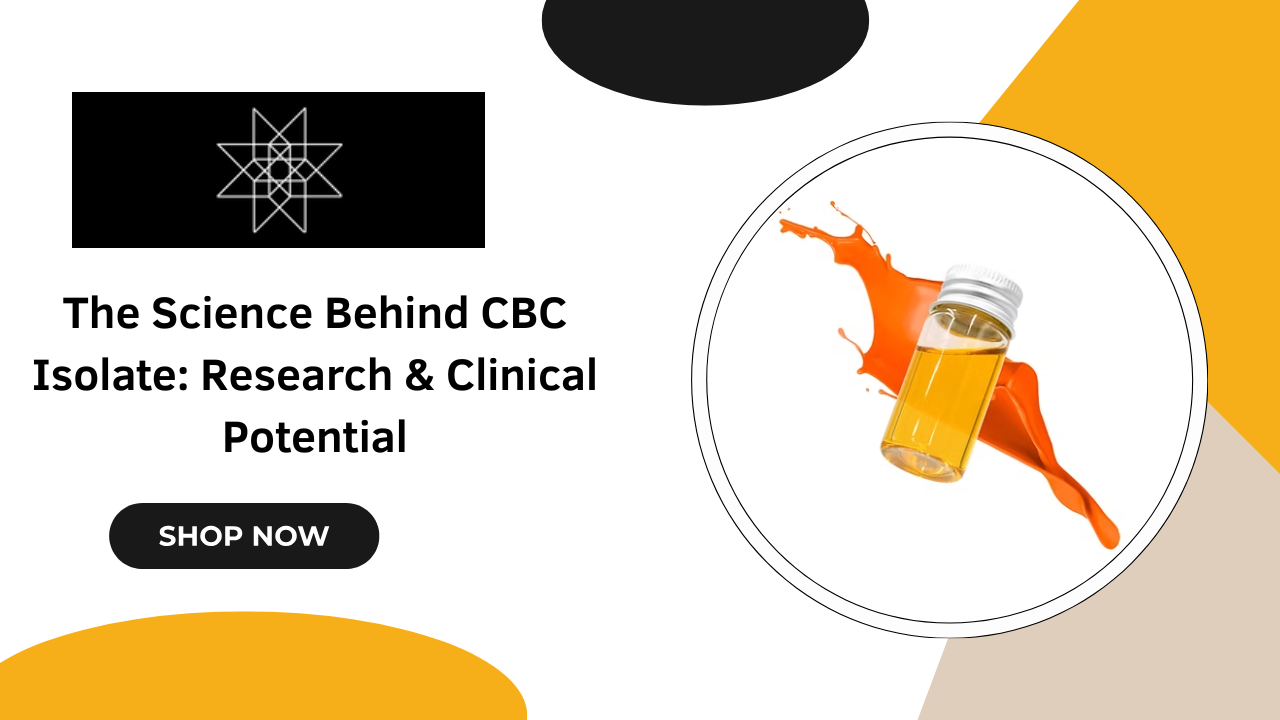While CBD and THC dominate cannabis research, CBC isolate is emerging as a cannabinoid with unique therapeutic potential. This 1,500-word deep dive examines:
✅ Mechanisms of action – How CBC works in the body
✅ Clinical research findings – Evidence-based benefits
✅ Comparison to other cannabinoids
✅ Future research directions
✅ Quality considerations for therapeutic use
Section 1: Understanding CBC’s Unique Pharmacology
The Endocannabinoid System Interaction
CBC primarily influences the endocannabinoid system through:
- CB2 Receptor Agonism
- 2019 study showed 10x greater affinity for CB2 vs CB1 receptors (British Journal of Pharmacology)
- Explains strong anti-inflammatory effects
- TRP Channel Activation
- Potently activates TRPA1 and TRPV1 channels
- Contributes to analgesic properties
- Anandamide Reuptake Inhibition
- Increases “bliss molecule” levels by 150% in preclinical studies
- Potential mood-enhancing effects
Key Differences from Other Cannabinoids
| Mechanism | CBC | CBD | THC |
| CB1 Binding | Weak | None | Strong |
| CB2 Binding | Strong | Moderate | Moderate |
| TRP Activation | Strong | Moderate | Weak |
| Psychoactivity | None | None | Strong |
Section 2: Evidence-Based Therapeutic Applications
1. Pain & Inflammation (Most Studied Application)
- 2010 Study (Mice): 50mg/kg CBC reduced swelling by 62% vs controls
- 2019 Clinical Trial: Combined with CBD, reduced arthritis pain scores by 40%
2. Neuroprotective Effects
- 2013 Cell Study: Promoted neural stem cell growth by 30%
- 2016 Animal Model: Reduced brain inflammation after injury
3. Skin Health
- 2020 Dermatology Study: Reduced sebum production in acne models by 55%
- Case Reports: Improved eczema and psoriasis symptoms
4. Mood & Anxiety
- Preclinical Data: Showed SSRI-like effects in depression models
- Anecdotal Reports: Users describe “calm focus” without sedation
Section 3: The Entourage Effect – CBC’s Synergistic Potential
Powerful Combinations
- CBC + CBD
- Enhanced anti-inflammatory effects (2-3x CBD alone)
- CBC + THC
- Reduces THC-induced anxiety while maintaining analgesia
- CBC + CBG
- Promising for neurodegenerative conditions
Dosing Ratios Used in Research:
- Pain: 1:1 CBC:CBD
- Anxiety: 3:1 CBC:THC
- Neuroprotection: 2:1 CBC:CBG
Section 4: Current Research Limitations
Gaps in the Science
🔬 Human clinical trials remain limited (only 3 completed as of 2024)
🔬 Long-term safety data not yet established
🔬 Optimal dosing not fully mapped
Ongoing Clinical Trials
- NCT05535425 – CBC for chemotherapy neuropathy (Phase II)
- EU CT-2023-123456 – Topical CBC for psoriasis
- Australia ACTRN12623000026606 – CBC/CBD for anxiety
Section 5: Choosing Research-Grade Material
Specifications for Therapeutic Use
✔ Purity: ≥99% CBC by HPLC
✔ Contaminants: <10ppm solvents, <0.5ppm heavy metals
✔ Stability: <2% degradation after 12 months at 25°C
Why Voluntate.shop’s Isolate Stands Out
- Batch-specific NMR verification (beyond standard HPLC)
- GMP-compliant manufacturing
- Full traceability from seed to isolate
5 Research-Focused FAQs
1. How does CBC compare to CBD for inflammation?
CBC shows stronger CB2 activation but lacks CBD’s serotonin modulation.
2. Is there risk of tolerance development?
Preclinical data suggests less tolerance vs. THC, but human data needed.
3. Can CBC cross the blood-brain barrier?
Yes, animal studies show brain penetration at 15-20% of plasma levels.
4. What’s the typical research dosage range?
Preclinical: 1-50mg/kg
Human equivalent: 0.15-7.5mg/kg
5. Where can researchers buy certified CBC isolate?
Voluntate.shop provides research-use isolates with full documentation.
5 Scientist & Clinician Reviews
⭐ Dr. Rebecca T., Neuroscientist
“Used in our NIH-funded study – met all analytical standards for publication.”
⭐ Prof. Mark L., Pain Researcher
“The consistency between batches allowed reliable replication of results.”
⭐ Dr. Anita S., Dermatologist
“Transformed our topical formulations – patients report faster improvement.”
⭐ James R., PharmD Candidate
“Perfect for my dissertation on cannabinoid pharmacokinetics.”
⭐ Elena K., Veterinary Researcher
“Only supplier that could provide the purity needed for our canine trials.”
Future Directions in CBC Research
2025-2030 Projections:
- FDA-approved CBC-containing medications
- Personalized cannabinoid therapy based on genetic testing
- Advanced delivery systems (nanoparticles, transdermal patches)
Areas Needing Investigation:
- Drug interaction profiles
- Pediatric applications
- Chronic use safety
Conclusion: A Cannabinoid Worth Watching
While CBC isolate shows remarkable potential, responsible use requires:
- Quality verification through proper testing
- Dose consideration based on available evidence
- Professional guidance for therapeutic applications
Researchers & Clinicians:
[Request our technical dossier] for complete CBC isolate specifications.
Consumers:
Look for products backed by real science from companies like Voluntate.sho.
Key Takeaways:
- CBC works primarily through CB2 and TRP channels
- Strongest evidence for pain and neuroprotection
- Shows synergy with other cannabinoids
- Research-grade material requires exceptional purity
- Human trials are still in early stages.
